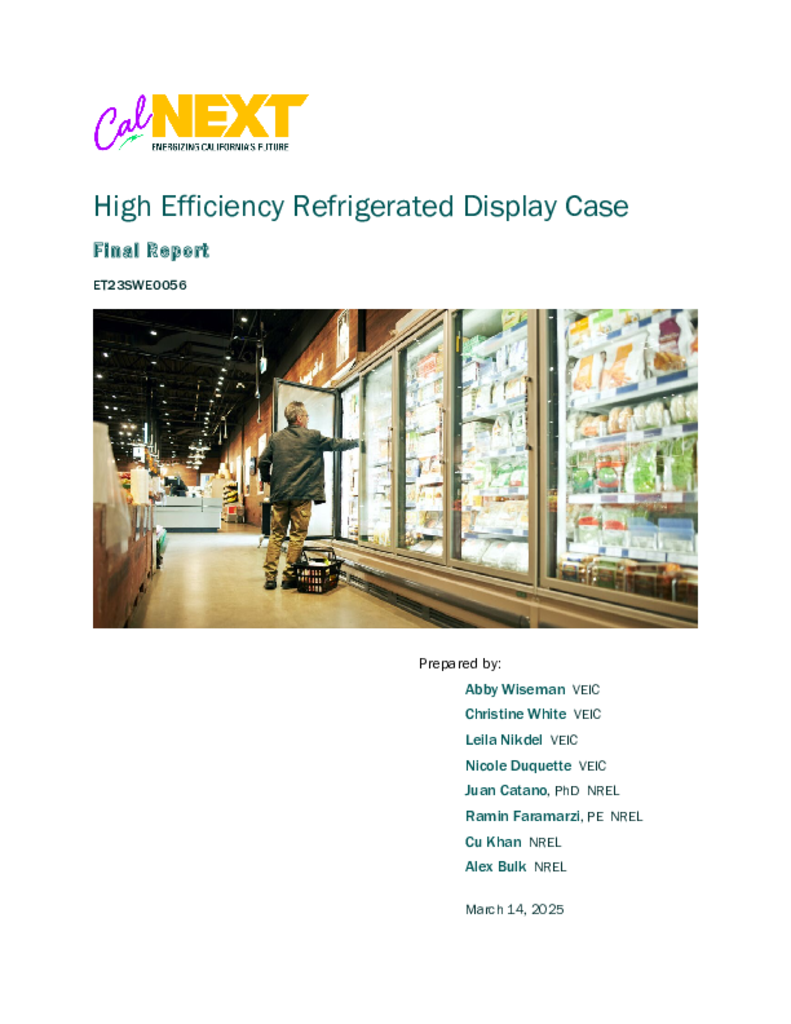ET23SWE0056 - High Efficiency Refrigerated Display Case
With 40-60 kWh per square foot electric usage intensity (EUI) supermarkets and grocery stores have one of the highest EUIs in the commercial buildings sector. Refrigeration accounts for roughly 50% of the electric energy and furthermore relies largely on Hydrofluorocarbon (HFC) refrigerants with high global warming potential (GWP). As a prerequisite for a viable decarbonization strategy, it is imperative for food retailers to significantly reduce energy use and electric demand of refrigeration systems. Additionally, as California policy makers enforce new regulations such as SB 1383 to achieve state greenhouse gas (GHG) reduction goals, it will be critical to understand the energy efficiency implications of low GWP refrigerants in commercial refrigeration applications.
According to 2020 Census data, the state of California has nearly 18,000 food retail establishments, which include convenience stores, grocery stores, supermarkets, warehouse clubs and supercenters. It’s estimated that these retailers operate more than 8 million linear feet of self-contained and remote condensing refrigerated cases. As new case technologies and low-GWP refrigerant options come into the market, high-efficiency self-contained refrigerated cases present an energy efficient and low carbon solution for food retailers to consider. Commercially available, these cases can play an instrumental role in paving the path for meeting California’s stringent energy and GHG targets.
VEIC and NREL propose to conduct a market potential study and technology performance assessment of high-efficiency, liquid-cooled, low-GWP, self-contained, medium temperature, refrigerated display cases with advanced controls. The performance will be measured against a baseline air-cooled, self-contained, medium temperature, HFC case without integrated controls. This baseline case is generally considered the industry standard for the majority of small food retailers and it has a ANSI/AHRI test standard against which the high-efficiency case can be comparatively measured. Elements of the high efficiency, vertical, low-GWP reach-in display case (RIDC) could include variable speed compressor technology, efficient heat exchanger materials, design for a R-290 propane refrigerant, and a water-cooled heat rejection loop. Manufacturers estimate that this type of high-efficiency case can reduce energy use by 30-50% and result in refrigerant charge size reductions of 95%.
The performance assessment will collect data on the baseline and efficient technologies and will use EnergyPlus modeling software to evaluate the impacts of the proposed technology on a building scale, including the interactive effects on the HVAC system and the potential for compressor waste heat reclaim. Performance characterization maps will be developed to estimate the range of energy, demand, and carbon savings across the food retailer market sector across California’s 16 climate zones.
A market characterization study will define and evaluate the potential opportunity for the proposed technology in California through review of existing research and literature, engagement with manufacturers, contractors, and end use retailers, and lab testing of equipment performance in controlled-environment design conditions. The data collected will identify potential barriers to market adoption, quantify the energy efficiency impacts, and assess the implications of low-GWP refrigerants which will be used to inform the scalability and support for measure adoption into investor-owned utility (IOU) program portfolios.
If approved, this project will be receive co-funding support from NREL in the form of access to research facilities and equipment.
This report is the market potential study and technology performance assessment of high efficiency, liquid-cooled, low-greenhouse-warming-potential (GWP), self-contained, medium-temperature, refrigerated display cases with advanced controls. The main objectives of this report are to quantify the energy use of these cases and to use the results to develop a building energy model to quantify the whole-building energy implications of using liquid-cooled cases. The results from the market study and assessment help to quantify energy use and opportunities for small (< 8,000 square feet) and large (> 8,000 square feet) grocery stores to transition to low-GWP refrigerants using micro-distributed systems (MDS). The recommendations provided in this study can be used to inform California investor-owned utility (IOU) energy efficiency programs to increase the adoption of high efficiency, liquid-cooled, self-contained, low-GWP refrigerated cases. Commercially available, these cases can play an instrumental role in achieving California’s energy efficiency and greenhouse gas reduction targets.

